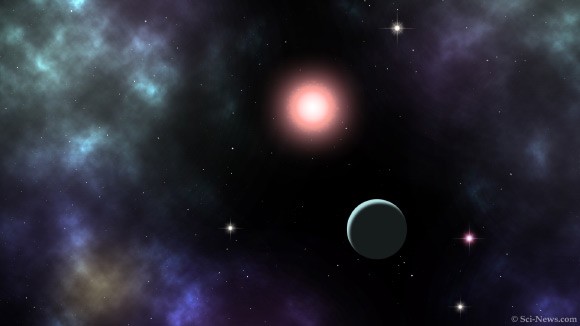Using data from NASA’s Transiting Exoplanet Survey Satellite (TESS) and several ground-based telescopes, astronomers have discovered and confirmed a sub-Neptune exoplanet near the habitable zone of TOI-2285 (also known as TIC 329148988), an M-dwarf star located 137 light-years away in the constellation of Cepheus. A paper describing the discovery will be published in the Publications of the Astronomical Society of Japan.

An artist’s impression of the sub-Neptune TOI-2285b and its parent star. Image credit: Sci-News.com.
“NASA’s Kepler space mission has revealed that planets with sizes between the Earth and Neptune (sub-Neptune-sized planets) are abundant in close-in orbits around stars other than the Sun,” Dr. Akihiko Fukui, an astronomer at the University of Tokyo and the Instituto de Astrofisica de Canarias, and colleagues wrote in their paper.
“Precise radius measurements for these planets have found that the ‘hot’ sub-Neptune-sized planets are classified into two populations: one is hotter and smaller planets and the other is cooler and larger planets, which are often referred to as super-Earths and mini-Neptunes, respectively.”
“Cooler sub-Neptune-sized planets also have an exciting possibility that they may retain liquid water under a hydrogen atmosphere, even if they reside outside of the habitable zone for rocky planets,” they added.
“If the planets have a water layer beneath the hydrogen atmosphere like Neptune and Uranus, then the hydrogen-water boundary could have the right conditions for water to be liquid.”
The newfound sub-Neptune has a radius of 1.74 times the Earth’s radii and a mass less than 19.5 times the Earth’s mass.
Named TOI-2285b, the planet has an orbital period of 27.3 days and resides just outside the habitable zone of the host star.
The alien world receives 1.54 times more light from the star than Earth receives from the Sun.
“TOI-2285b is one of only a handful of low-insolation sub-Neptune-sized planets transiting bright host stars, among which LHS 1140b and TOI-1266c have similar sizes to the newfound planet with measured masses,” the astronomers wrote.
Although TOI-2285b resides just outside the habitable zone for a rocky planet, if the planet harbors a water layer under a hydrogen-rich atmosphere, then liquid water could exist on the surface of the water layer.
“The bright host star in near infrared makes this planet an excellent target for further radial velocity and atmospheric observations to improve our understanding on the composition, formation, and habitability of sub-Neptune-sized planets,” the researchers concluded.
_____
Akihiko Fukui et al. 2021. TOI-2285b: A 1.7 Earth-radius Planet Near the Habitable Zone around a Nearby M Dwarf. Publ. Astron. Soc. Japan, in press; arXiv: 2110.10215







